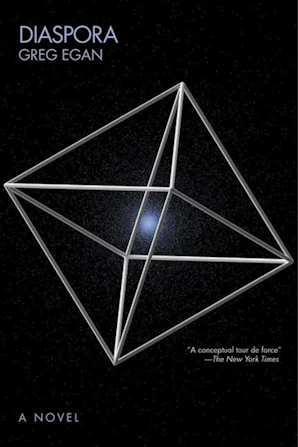
There’s hard science fiction, and then there’s Greg Egan. One might imagine hard science fiction by picturing a worn universe, spaceships that rotate to create gravity, a technological future one can extrapolate from the world we live in today, always adhering to the rules of physics as we know them. Greg Egan does all of that, and adds math. If you want hardcore mathematical science fiction, Greg Egan is for you. Here’s more from the wonderful site Mathematical Fiction:
Still, this story which focuses on the “lives” of virtual beings in a computer contains some really nice mathematical fiction. I especially like the section in which one virtual being helps another (a “baby”) to figure out the Gauss-Bonnet theorem. The question was posed in a rather sophisticated way, demonstrating real understanding: why is it that we cannot put any curvature we want onto a manifold? Isn’t it merely a matter of the embedding (also defined in the glossary)? Of course, the answer is “No, there are topological restrictions”, but how do you help someone to see that? Here, the teacher, Radiya, presents the pupil, Yatima, with a virtual triangulation of a sphere and asks “ver” (pronouns all start with “v” here) to try to make it flat:
(quoted from Diaspora): “Ve tried smoothing and flattening the six points. That was easy — but it made the eight triangles as bowed and non-Euclidean as they’d been on the original sphere. It seemed “obvious” that the points and the triangles could never be made flat simultaneously…but Yatima still couldn’t pin down the reason why the two goals were irreconcilable. Ve measured the angles where four triangles met, around what had once been a point of the diamond: 90, 90, 90, 90. That much made perfect sense: to lie flat and meet nicely without any gaps, they had to add up to 360 degrees. Ve reverted to the unblunted diamond, and measured the same angles again: 60, 60, 60, 60. A total of 240 was too small to lie flat; anything less than a full circle forced the surface to roll up like the point of a cone… That was it! That was the heart of the contradiction! Every vertex needed angles totaling 360 degrees around it, in order to lie flat…while every flat Euclidean triangle supplied just 180 degrees. Half as much. so if there’d been exactly twice as many triangles as vertices everything would have added up perfectly — but with six vertices and only eight triangles, there wasn’t enough flatness to go around.”
- SEO Powered Content & PR Distribution. Get Amplified Today.
- PlatoData.Network Vertical Generative Ai. Empower Yourself. Access Here.
- PlatoAiStream. Web3 Intelligence. Knowledge Amplified. Access Here.
- PlatoESG. Carbon, CleanTech, Energy, Environment, Solar, Waste Management. Access Here.
- PlatoHealth. Biotech and Clinical Trials Intelligence. Access Here.
- Source: https://blog.adafruit.com/2024/06/09/the-hardest-sci-fi-writer-greg-egan-scifisunday/



